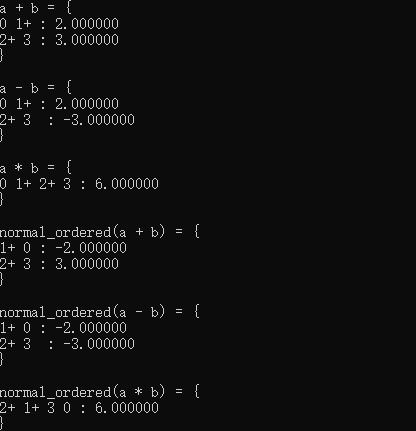费米子算符类¶
我们用如下的记号标识来表示费米子的两个形态, 湮没: \(X\) 表示 \(a_x\) , 创建: \(X +\) 表示 \(a_x^\dagger\) , 例如: "1 + 3 5 + 1"则代表 \(a_1^\dagger \ a_3 \ a_5^\dagger \ a_1\)
整理规则如下
1. 不同数字
\["1\quad 2" = -1 * "2\quad 1"\]
\["1 + 2 +" = -1 * "2 + 1 +"\]
\["1 + 2" = -1 * "2\quad 1 +"\]
2. 相同数字
\["1\quad 1 +" = 1 + "1 + 1"\]
\["1 + 1 +" = 0\]
\["1\quad 1" = 0\]
跟 PauliOperator 类似,FermionOperator 类也提供了费米子算符之间加、减和乘的基础的运算操作。通过整理功能可以得到一份有序排列的结果。
实例¶
#include "Components/Operator/FermionOperator.h"
int main()
{
QPanda::FermionOperator a("0 1+", 2);
QPanda::FermionOperator b("2+ 3", 3);
auto plus = a + b;
auto minus = a - b;
auto muliply = a * b;
std::cout << "a + b = " << plus << std::endl << std::endl;
std::cout << "a - b = " << minus << std::endl << std::endl;
std::cout << "a * b = " << muliply << std::endl << std::endl;
std::cout << "normal_ordered(a + b) = " << plus.normal_ordered() << std::endl << std::endl;
std::cout << "normal_ordered(a - b) = " << minus.normal_ordered() << std::endl << std::endl;
std::cout << "normal_ordered(a * b) = " << muliply.normal_ordered() << std::endl << std::endl;
return 0;
}
